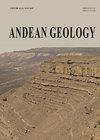Comment on “Crustal faults in the Chilean Andes: geological constraints and seismic potential” by Santibáñez et al. (2019), Andean Geology 46 (1): 32-65
IF 1.2
4区 地球科学
Q3 GEOLOGY
引用次数: 2
Abstract
Understanding the location and nature of Quaternary active crustal faults is critical to reduce both the impact of fault rupture and strong ground motions hazards (when these faults rupture causing earthquakes). It is also important for understanding how and where deformation related to plate tectonics is accommodated along geological structures (oftentimes faults and folds). In Chile, work on active tectonics in the upper crust (neotectonics or earthquake geology) is relatively new, in particular regarding fault-focused studies. Therefore, any effort to further progress in our understanding of active fault systems for the benefit of the public, and for aiding local and regional governments and the earthquake engineering and scientific community with mitigation strategies should be applauded. Demonstrating where active faults are located through careful mapping, and to determine how fast they accommodate tectonic deformation and their seismic and fault rupture hazards are key questions in neotectonics. Recently Santibanez et al. (2019) explore active fault systems in the Chilean Andes. In their paper they outline active and potentially seismogenic (i.e., earthquake producing) fault systems in the Chilean Andes through a review of the literature, seismicity, case studies (earthquakes), and modeling data and then they define potential tectonic domains for subdivision of Chile. These domains were suggested to allow “a first-order approach for seismic potential assessment” (Santibanez et al., 2019). The three subdivisions they suggest, i.e., domains are the External Forearc, Inner Forearc and Volcanic Arc, were proposed based on several fault parameters (e.g., fault length), case studies, the morphotectonic setting and seismicity. Their paper generates a great foundation to build upon for both the active tectonics and geological hazards community, in addition to being useful for potential end users such as the Chilean local and national government from a planning perspective. Although the Santibanez et al. (2019) paper takes steps in the right direction, and should be considered an important contribution to the scientific community, this comment addresses three potential issues with their analysis and conclusions that should be reflected upon by the seismic hazard and active tectonics community. These ideas are summarized below and expanded on in detail thereafter.Santibáñez等人对“智利安第斯山脉地壳断层:地质约束和地震潜力”的评论。(2019),安第斯地质学46(1):32-65
了解第四纪地壳活动断层的位置和性质对于减少断层破裂的影响和强地震动的危害(当这些断层破裂引起地震时)至关重要。这对于理解与板块构造相关的变形是如何以及在哪里沿着地质构造(通常是断层和褶皱)进行调节也很重要。在智利,对上地壳活动构造(新构造学或地震地质学)的研究相对较新,特别是对断层的研究。因此,为了公众的利益,为了帮助地方和地区政府、地震工程和科学界制定减灾战略,任何进一步增进我们对活动断层系统的理解的努力都应该受到赞扬。通过仔细的测绘来显示活动断层的位置,并确定它们适应构造变形的速度及其地震和断层破裂的危险是新构造学的关键问题。最近,Santibanez等人(2019)探索了智利安第斯山脉的活动断层系统。在他们的论文中,他们通过对文献、地震活动、案例研究(地震)和建模数据的回顾,概述了智利安第斯山脉活跃的和潜在的发震(即产生地震)断层系统,然后他们定义了智利细分的潜在构造域。建议这些域允许“一阶地震潜力评估方法”(Santibanez et al., 2019)。他们根据断层参数(如断层长度)、案例研究、形态构造背景和地震活动性提出了三个细分领域,即外前弧、内前弧和火山弧。他们的论文为活跃构造学和地质灾害学界提供了一个很好的基础,此外,从规划的角度来看,对智利地方和国家政府等潜在的最终用户也很有用。尽管Santibanez等人(2019)的论文朝着正确的方向迈出了一步,并且应该被认为是对科学界的重要贡献,但这篇评论通过他们的分析和结论解决了三个潜在问题,这些问题应该被地震危害和活动构造界所反映。下面总结了这些想法,并在后面详细展开。
本文章由计算机程序翻译,如有差异,请以英文原文为准。
求助全文
约1分钟内获得全文
求助全文
来源期刊

Andean Geology
地学-地质学
CiteScore
3.90
自引率
0.00%
发文量
17
审稿时长
>12 weeks
期刊介绍:
This journal publishes original and review articles on geology and related sciences, in Spanish or English, in three issues a year (January, May and September). Articles or notes on major topics of broad interest in Earth Sciences dealing with the geology of South and Central America and Antarctica, and particularly of the Andes, are welcomed.
The journal is interested in publishing thematic sets of papers and accepts articles dealing with systematic Paleontology only if their main focus is the chronostratigraphical, paleoecological and/or paleogeographical importance of the taxa described therein.
 求助内容:
求助内容: 应助结果提醒方式:
应助结果提醒方式:


